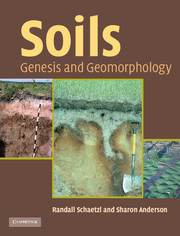Book contents
- Frontmatter
- Contents
- Preface
- Acknowledgements
- Part I The building blocks of the soil
- Part II Soil genesis: from parent material to soil
- Part III Soil geomorphology
- 13 Soil geomorphology and hydrology
- 14 Soil development and surface exposure dating
- 15 Soils, paleosols and paleoenvironmental reconstruction
- 16 Conclusions and Perspectives
- References
- Glossary
- Index
16 - Conclusions and Perspectives
from Part III - Soil geomorphology
- Frontmatter
- Contents
- Preface
- Acknowledgements
- Part I The building blocks of the soil
- Part II Soil genesis: from parent material to soil
- Part III Soil geomorphology
- 13 Soil geomorphology and hydrology
- 14 Soil development and surface exposure dating
- 15 Soils, paleosols and paleoenvironmental reconstruction
- 16 Conclusions and Perspectives
- References
- Glossary
- Index
Summary
With the exception of ice-covered surfaces, areas of bare bedrock and perhaps a few others, soils of one kind or another exist on every part of the Earth's land surface. The wide variety and range of expression that soils have is truly remarkable, especially when one considers that this plethora of colors, mineral assemblages and horizon types and sequences is due to the interaction of only a few (5) soil-forming factors. In mathematics, 5 is a small number but 55 is much, much larger. So it is in soils, as those five soil-forming factors can team together in myriad ways to form a world of soils that is complex, spatially diverse and manyfaceted. Unraveling that world, or at least some of the better-understood parts of it, is a goal of this book.
Almost all of our food and sustenance comes from the soil. The oxygen that we breathe come from plants, most of which are rooted in the soil. Soil is one of the best natural filters we have for contaminated surface waters. Many Christians may know that the name “Adam” comes from the Hebrew adama, which means earth, or soil. Adam's name, in Genesis, is meant to capture humankind's intimate link with the soil, to which we are tied through our entire life and to which we return upon our death (Hillel 1991). Clearly, soils have been a part of humankind for as long as we have existed and will be here long after we are gone.
- Type
- Chapter
- Information
- SoilsGenesis and Geomorphology, pp. 653 - 656Publisher: Cambridge University PressPrint publication year: 2005



